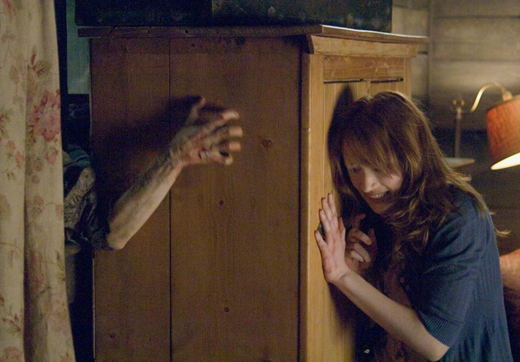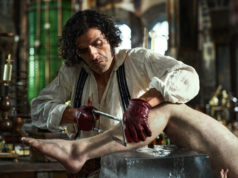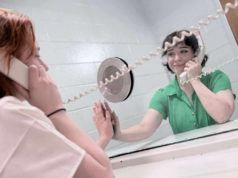
I was planning to lead off this blog post with a definition of “Pirandellian device,” but I found that there’s not a whole lot of agreement out there about what that is. The reference comes from the work of Luigi Pirandello, the Italian playwright who was one of the great modernizers of 20th-century theater. Some writers use “Pirandellian device” to refer to a blurring of the lines between theatrical spectacle and audience (such as in Woody Allen’s movie The Purple Rose of Cairo). There is indeed some of this in Pirandello, but when I used the term, I was referring to it as a character becoming aware that they are a character. This happens most notably in Pirandello’s Six Characters in Search of an Author, in which a family’s melodrama is played out on a stage in front of a bunch of uncomprehending actors and director, who are incapable of doing justice to their story. As I mentioned in my review of The Cabin in the Woods, the characters become aware that they are characters, and their self-awareness keys the rest of the movie.
I’ve got more on this, but in case you missed it in the headline: WARNING: SPOILER ALERT! THIS BLOG POST GIVES AWAY MAJOR PLOT DEVELOPMENTS IN THE FILM! DO NOT READ FURTHER IF YOU WISH TO BE SURPRISED!
The movie posits a mythology behind slasher plots that unifies all horror movies everywhere. It turns out that every government in the world is performing ritual sacrifices of young people to appease the ancient gods that live underneath the ground. Other countries use different methods, and we get a terribly funny glimpse of a bunch of Japanese schoolgirls screaming and running from a levitating long-haired ghost. The governments keep various monsters on hand to do the killing. In return for the blood of the innocents, the gods allow the humans to rule the Earth. However, the countries have been failing in their task one by one and being reclaimed by the gods, so by the time the movie begins, America and Japan are the only countries still standing.
The survivors from the cabin learn the truth from The Director (Sigourney Weaver), who is never properly named. That title is slippery, implying that she’s a program director like NASA might have overseeing teams of its technicians, but also implying that she fulfills the same role as a movie director. She explains that the gods need the blood of specific personality types: The Whore, The Athlete, The Scholar, The Fool, and The Virgin. There’s a hilarious reaction to this from good girl Dana (Kristen Connolly): “Virgin? Me?” The Director responds, “We work with what we have.”
This gets to the heart of a big question: Why do we have slasher flicks? Why do we find entertainment in the relentless slaughter of young people? My take on it is that it serves the same purpose as the ancient tradition of the memento mori. The ultimate faceless slasher is the Grim Reaper, and he comes for all of us, the strongest of us, the smartest of us, the prettiest of us, the funniest of us, the purest of us. Young people need this reminder more than anybody else, and so the victims in slasher flicks are usually teens. However, Joss Whedon and Drew Goddard have instead turned this toward a different end, namely a meditation on the meaninglessness of the cosmos.
The characters’ realization that they are no more than sacrificial lambs results in existential horror, which is a different kind of horror from the one caused by a redneck zombie torturer family chasing you through the woods. Human existence may be fundamentally absurd, but it doesn’t get much more absurd than finding out that your ultimate destiny is to be slaughtered by redneck zombie torturers so that the rest of the human race can go blithely about its business. You can’t blame a person for being angry at that. Realizing this, Dana screams not out of fear but out of rage at the forces that have put her in that situation. I love that moment. Granted, some horror movie aficionados find all this too intellectual, and I can understand that. Still, I like the particularly contemporary strain of horror that goes with the hilarity, a blend that Pirandello would have recognized, even if he wouldn’t have been comfortable with the zombies. Plus, any movie this funny gets a pass from me regardless of what else it does.
Lots of movie sites are comparing this movie to other “cabin in the woods” horror flicks. I’d rather review the history of funny slasher movies, and they include two “cabin” movies that the other lists have largely overlooked: Christopher Smith’s 2007 film Severance, about a bunch of British white-collar employees preyed on by backwoods killers during a company retreat, and Tommy Wirkola’s 2009 movie Dead Snow, about a group of Norwegian skiers who run afoul of Nazi zombies. These movies both have some very funny moments, and they belong to a tradition all its own of funny slasher movies, which play havoc with the genre’s highly codified rules. These include the Scream movies, which pioneered the subgenre, and the Scary Movie series, which went all-out for gags and wound up parodying movies far removed from the slasher genre. All the Boys Love Mandy Lane also belongs here, even though it’s purposefully not nearly as funny as the others, it still calls attention to the genre’s archetypes. The intermittently brilliant Tucker & Dale vs. Evil, which came out just last year, is another entry. The best of these is Scott Glosserman’s savvy 2007 parody Behind the Mask: The Rise of Leslie Vernon, which interviews the slasher and reveals him behaving like a narcissistic actor.
The Cabin in the Woods trumps all these movies by being funnier and better thought out. The other great funny horror movies of recent years (Shaun of the Dead, The Host, Jennifer’s Body, and Zombieland) survive comparison with it only by being fundamentally different. The moment late in the movie when Dana unleashes all the monsters on the scientists isn’t just primally satisfying, it’s as close as I’ve ever seen a movie come to the frenzied imaginings of a Hieronymus Bosch painting. That alone makes the movie worth seeking out.











